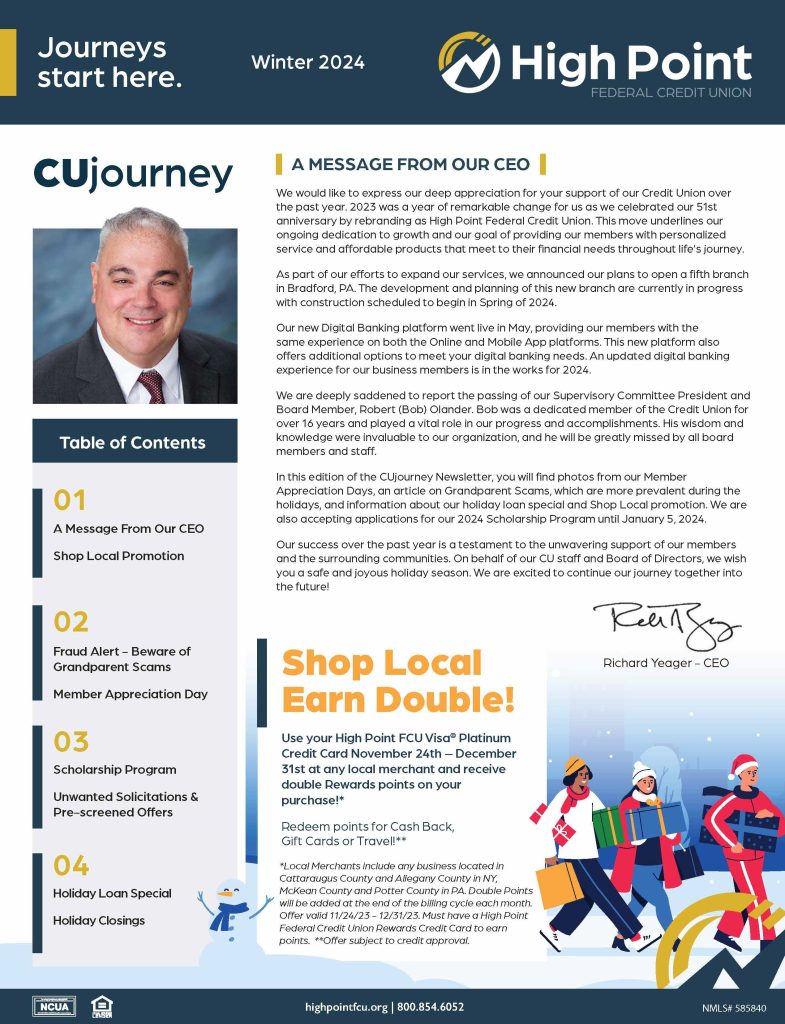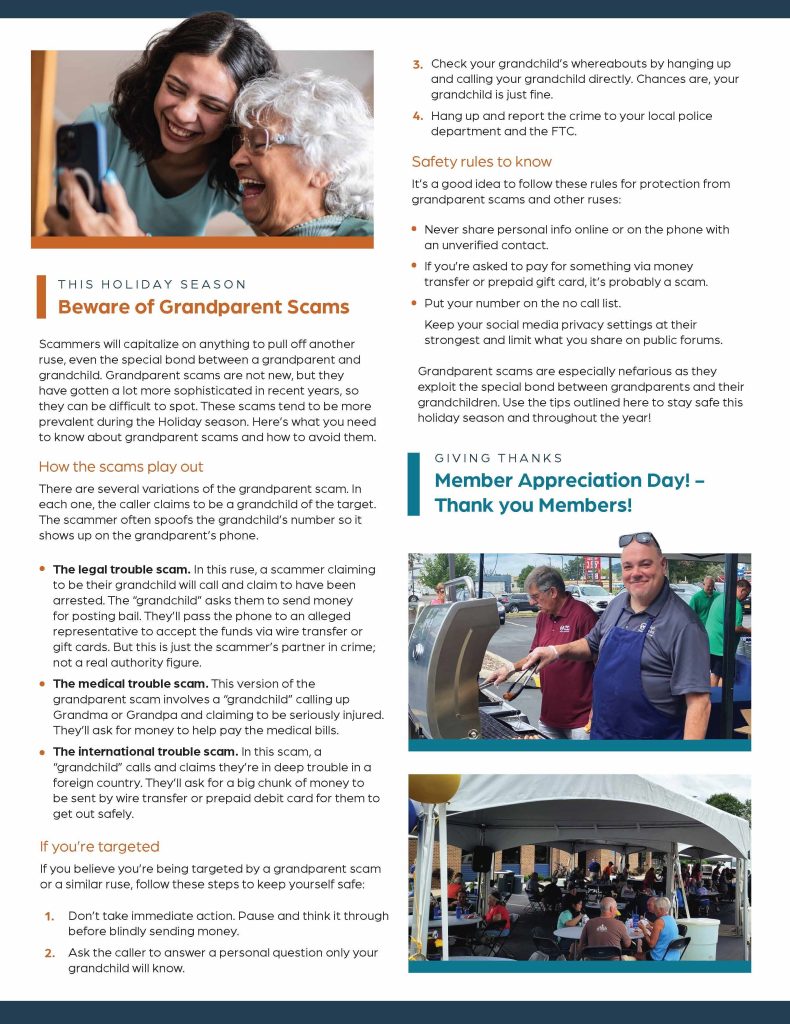News from your CU!
High Point Winter Newsletter




Routing #: 222381824
Digital Banking
Q: Holiday shopping season is here, but I can’t pay for it all! What’s the best way to fund my holiday shopping?
A: When it comes to covering the cost of your holiday shopping, you have several choices. Let’s take a look at some options and explore the pros and cons of each so you can make an informed decision.
For many shoppers, the most obvious way to pay for a purchase you can’t cover now is with a credit card.
Pros:
Cons:
Dipping into savings to pay for your holiday purchases can free you from sky-high interest charges but comes with drawbacks.
Pros:
Cons:
An unsecured loan, also known as a personal loan or holiday loan, is a loan that’s taken out with no collateral.
Pros:
Cons:
Check out our Holiday Loan Special!
When you open a holiday club account , you’ll make regular contributions toward your set goal throughout the year, and then have funds you’ll need for covering your holiday purchases when the season arrives.
Pros:
Cons:
Use this guide to make an informed choice about paying for your holiday shopping.
Knock, knock! It’s your energy company, here with the bad news that your bill is overdue, so we’re shutting off your electricity unless you pay up right now.
Sounds like a nightmare, right? Well, it’s going to get worse: this is a scam. Pay the visitor at your door, and you’ve just paid a scammer.
It’s happening a lot more lately. So, here’s what you need to know about these scams and how to keep the lights on without falling victim.
In a utility scam, a target receives a phone call, email, text message or even an in-person visit from an alleged representative of their gas, water or electric company. This “rep” will claim to be collecting a past due account that’s pending shutoff unless payment is made immediately. They’ll often ask for the payment to be made via wire or through a prepaid gift card. Unfortunately, any money paid will go directly to the scammer, and not to the utility entity they claim to represent.
Do not engage with the caller or visitor. If the alleged rep sent you an email or text message, mark it as spam, block the address and do not respond. You can also call the company the scammer claimed to represent to confirm that your account is not pending shut off.
Watch out for these red flags which can help you avoid a utility scam:
To avoid utility and similar scams, follow these precautionary measures:
Utility scams pose a real threat to your financial security. Follow these tips to stay safe!
Hosting a Thanksgiving dinner is an enjoyable, rewarding experience, but it can also be a bit much for many of us. The expenses can be sky-high, the to-do list seems endless and the dinner itself can be a harried and breathless affair that puts a damper on any holiday cheer.
Here’s the good news: It doesn’t have to be this way. Consider these 10 hosting hacks to help you enjoy a calm and stress-free Thanksgiving that doesn’t break the budget.
Instead of waiting for the overwhelm to hit a week before Thanksgiving, start planning now. Look through your favorite recipe blogs, food magazines and cookbooks to compile a list of dishes you want to serve. Reach out to friends and family who are joining you for Thanksgiving dinner and inquire about what, if any, dishes they plan to bring. At this time, you can also ask about any dietary restrictions any of your guests may have.
Next, make a detailed menu and start listing the ingredients you’ll need to purchase. You can also jot down any other purchases you’ll need to make, such as decor items and serving dishes. Aside from making your prep easier, planning your menu and purchases early will help you make more responsible money choices as you shop.
Next, start scheduling the tasks you’ve just listed into your weekly and daily schedules. For example, a few weeks before Turkey Day, you can shop for drinks and any dry and frozen ingredients. You can do all the baking two weeks before the big day, prep your marinades, sauces and salad dressings a week before, the appetizer and sides a few days prior to Thanksgiving, and finally, the entrees on Thanksgiving Day. You may want to write everything down on a calendar so you can get a clear snapshot of what you need to do each day with just one glance.
Of course, if you prefer to marathon-cook for seven hours straight on the day before Thanksgiving, that can work, too. Just make sure you’ve taken care of all the other to-dos, such as shopping and planning the decor, well in advance.
If you hate missing all the best parts of the conversation at the Thanksgiving table because you’re busy in the kitchen, you may want to consider a buffet-style meal. While it’s definitely a departure from the traditional sit-down dinner, a serve-yourself meal can be a great way to make things easier for you. You can also get away with offering fewer dishes when it’s all served at one time instead of a formal meal with staggered courses.
If no one’s offered to help you cook, don’t be afraid to assign small jobs to your guests so they can be part of the prep. It doesn’t have to be anything too time-consuming on their part, but for you, just knowing that Cousin Jen is bringing the mashed potatoes and your mom will bring her famous pecan pie for dessert means two menu items off your head.
If you’re hosting families with children, create a kid-friendly area with games, coloring books and activities to keep the little ones engaged. This way, parents can enjoy the meal without worrying about bored and restless kids. You can also offer kid-friendly menu options like fries and chicken nuggets to keep guests of all ages happy and well-fed.
Are you ready for a super-quick clean up when the party’s over? With today’s robust dinnerware options, you can have your convenience without compromising on your conscience. There are so many eco-friendly disposable options, from compostable cutlery to bamboo plates and so much more.
Create a self-serve drink station with a variety of beverages to cater to different preferences. Include water, non-alcoholic options and a signature Thanksgiving cocktail to keep things festive. This encourages guests to help themselves, freeing you up to focus on other aspects of hosting.
With so much going on at the table, there’s no need to overthink the centerpiece. A simple wooden board filled with seasonal gourds will add that festive touch to the table without breaking the budget. Add some pillar candles from a dollar store to complete the look.
If you’re hosting a crowd, consider cooking two small birds instead of one large one. You’ll save on defrosting time, freezer space and the stress of choosing the perfect recipe. You may even save money on your entree by splitting it into two with this hack.
The best part about being the host is that no one has to know what you’d planned to serve. So if you’re finding that one dish is stressing you out and will cost more than it’s worth at your table, just let it go. Leave it out, and no one will know the difference.
Despite what personal experience may tell you, Thanksgiving does not have to be stressful or expensive. Use these hacks for a stress-free Thanksgiving holiday.
In today’s digital world there’s an app for practically everything; the weather, mobile banking, socializing, games, entertainment… the list goes on. There are millions of downloadable apps for your phone and electronic devices. With all these convenient apps, there’s more ways for fraudsters to take advantage of innocent mobile app users. Unfortunately, mobile app fraud can come in numerous forms and is not always easy to identify. Here’s some things to look out for: